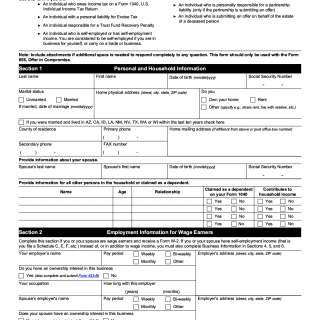IRS Form 433-A. Collection Information Statement for Wage Earners and Self-Employed Individuals
IRS Form 433-A, Collection Information Statement for Wage Earners and Self-Employed Individuals, is a form used by individuals who owe taxes to the Internal Revenue Service (IRS) and need to provide detailed information about their financial situation to the IRS. The main purpose of this form is to provide the IRS with a comprehensive picture of the taxpayer's financial situation to determine the most appropriate course of action to resolve the tax debt.
The form consists of several parts, including personal information about the taxpayer, details about the taxpayer's income, expenses, assets, and liabilities, and certification by the taxpayer. The important fields to consider when compiling/filling out this form include the taxpayer's name, address, and social security number, as well as detailed information about the taxpayer's income, expenses, and assets.
The parties involved in the completion of this form include the taxpayer and the IRS. It is important to consider the accuracy and completeness of the information provided on the form, as any discrepancies or omissions could result in further action by the IRS.
When compiling/filling out this form, the taxpayer will need to provide detailed information about their income, expenses, assets, and liabilities. Additionally, the taxpayer may need to attach supporting documents, such as bank statements, pay stubs, and proof of expenses.
Examples of when this form may be needed include when an individual owes taxes to the IRS and is unable to pay the full amount owed. The strengths of this form include the ability to provide the IRS with a comprehensive picture of the taxpayer's financial situation, which can help to determine the most appropriate course of action to resolve the tax debt. The weaknesses of this form include the potential for the information provided to be used against the taxpayer in collection actions by the IRS.
Related forms include Form 433-B, Collection Information Statement for Businesses, which is used to provide the IRS with detailed financial information about a business, and Form 433-F, Collection Information Statement, which is used for individuals who owe taxes but are not self-employed. An analogue of this form is a personal financial statement, which provides a comprehensive picture of an individual's financial situation.
The completion of this form can affect the future of the taxpayer by providing the IRS with the information necessary to determine the most appropriate course of action to resolve the tax debt. The form is submitted to the IRS and stored in their records.

